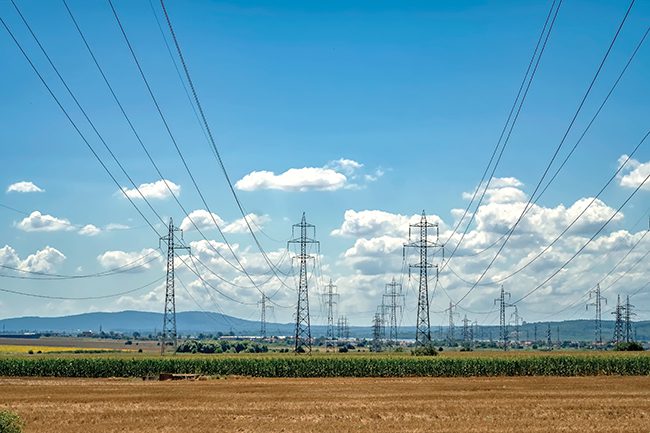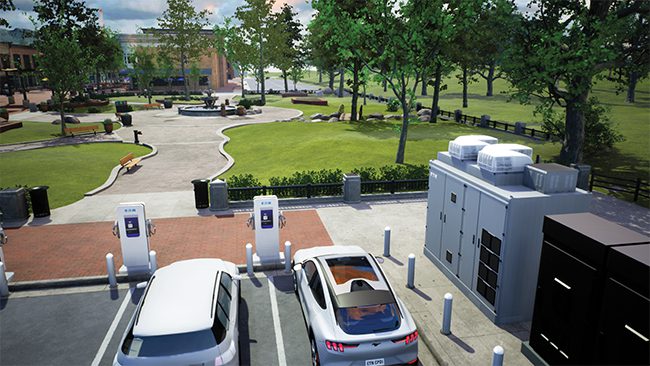Driving on Electric Avenue—Innovation Pushes Energy Transformation
A seismic shift is ongoing in the energy space, as transportation, industry, and other sectors turn toward electricity and away from fossil fuels to supply their power.
The push for decarbonization of the electric power sector has several elements, though many in the industry sum up the movement with one word: electrification. Replacing technologies that use fossil fuels to produce electricity, and instead relying on resources that reduce or eliminate carbon emissions, has brought plenty of debate.
 |
|
1. Energy experts have said upgrades to infrastructure, and certainly to the transmission grid, will be needed to support increased electrification. Source: Envato Elements |
Much of the discussion centers on whether the power grid (Figure 1) can handle increased demand from electric vehicles (EVs), from the commercial and industrial sector for heating and cooling, and from a residential community being urged to replace natural gas–powered furnaces and appliances with all-electric equipment such as heat pumps and induction cooktops.
Those who spoke with POWER repeatedly noted the fight against climate change as a reason to support electrification, saying reducing the use of fossil fuels is critical to decarbonizing the economy and meeting climate goals. There is concern, though, that the transmission grid is not ready to support a significant increase in demand for electricity, as infrastructure already is challenged when it comes to resiliency and reliability of the power supply.
“No one entity is responsible for the push toward electrification; however, every business entity and economic sector has a lot to gain from electrification’s impacts on the energy grid,” said Hari Nayar, vice president of Fleet Electrification and Sustainability at Merchants Fleet, a national fleet management company. “Up until recently, the grid has grown organically to support demand but has not been the focus of proactive investments to improve its modernity, security, and resiliency that we are now seeing due to surface transport electrification.”
Nayar said, “Though I believe the responsibility for pushing electrification is shared, we are seeing certain sectors eagerly lean in to take the lead. Demand from both the commercial and passenger vehicles industry has been surging thanks in part to massive investments in R&D [research and development] from the OEMs [original equipment manufacturers] and enticing government incentives. Many experts think that the utility sector will be ready to generate enough power for the electrification wave through planned capacity increases and efficiency improvements in other sectors, but that doesn’t mean that residential homes and businesses are equipped for this power distribution.”
Nayar, like others who spoke with POWER, said, “One limiting factor is the speed and scale at which the infrastructure can be put into place. Some grid operators are already struggling to keep up with demand in certain areas, and power authorities fear the possibility of blackouts with the overloading grid use.”
Working Smarter and Harder
Utilities and other power generators planning for electrification know there’s more to it than just managing loads on the power grid. Nelly Maximous, vice president, Energy Transition for Eaton in North America, told POWER, “Electrification is not just about adding new load to the grid or building industrial or home energy systems. It requires that existing energy systems work smarter and harder to accelerate decarbonization and optimize how energy is used through intelligence, control, and automation.
“The bottom line is that today’s electrical systems need to do much more than just receive power from the electric grid,” said Maximous. “Now, and in the future, there is an enormous opportunity to manage power far more effectively, taking advantage of the levers available with the energy transition including integrating renewables and energy storage.”
 |
|
2. Adding EV charging infrastructure with energy storage and onsite solar can help existing energy systems support added electricity demand and enable more flexibility. Courtesy: Eaton |
Many in the energy sector believe any discussion of electrification must begin with the transportation/e-mobility sector, from EVs (Figure 2) to trains, boats, planes, and more. Dan O’Shea, director of Utility Strategy and Business Development for ABB, told POWER: “If we were to reach a 100% electrified car fleet, we could expect an increase in total electricity demand of up to 10–20% depending on the country and the level of industrialization. In the short term, over the next five years, given the current rates of e-mobility adoption, we should see little impact on the grid. This is even taking into consideration countries such as Norway where over 50% of new cars are EVs.”
O’Shea continued: “Currently, overall predictions signal that electricity demand will grow 3,000 TWh by 2040 as a result of electric vehicles. This would see a compound annual growth rate increase of 1.6% in today’s utilities, which on a macro basis could be managed through existing planning processes.”
Several utilities already have created jobs and business divisions devoted to electrification and its impact on power generation and the grid. Said O’Shea, “The challenges we can anticipate associated with mass EV charging include geographical distribution, where distribution transformers may need to be replaced due to overloading given that the energy load will be unevenly distributed over their system; power peaks throughout the day, as car power increases and consumer demand for faster charging grows; and rush hour peak demand. Given that two-thirds of the demand will be for cars and buses, there will likely be an afternoon rush hour peak possibly reaching half of this new demand.”
Geography Lesson
Geographic distribution also plays into electrification efforts in the residential sector. Some municipalities are moving to ban natural gas hookups in new construction; there’s been debate about banning gas stoves due to methane emissions. Such measures would impact electricity loads in those jurisdictions, but Paula Glover, president of the Alliance to Save Energy, told POWER policymakers should consider other factors before pushing changes.
“The most important aspects of electrification are the cost of conversion for the end user, energy costs post-conversion, and energy efficiency,” said Glover. “An end-user cost analysis is particularly critical when considering impacts on low-income and disadvantaged communities. If the cost of conversion or cost of energy post-conversion places the consumer in a worse position than she would have been in but for electrification, then policymakers must identify strategies and solutions to fully eliminate the harm.”
A poll conducted by Siena Research in New York state, published in late February, said just 39% of respondents approve of a proposal to basically ban any fossil fuel–burning equipment—including gas-powered stoves—in new residential construction. The costs of equipment, such as heat pumps and more—which often require an upgrade to a home’s electrical panel—are top of mind for many of those concerned about a full-on push to electrify.
“Electrification should not be pursued absent an initial investment in energy efficiency, including sealing the building envelope and retrofitting the home with the high-efficiency equipment and appliances,” said Glover. “Focusing on energy efficiency first will help define equipment capacity needs, and will further lower energy use for the consumer, reducing their energy costs. If electrification is the policy objective, then all identified parties should be involved in its implementation, including direct engagement at the community level, particularly when considering low-income and disadvantaged communities.”
Climate Change
Electrification is often seen as critical to decarbonization, and as such, part of the discussion around climate change. Anders Sjoelin, president and CEO of S&C Electric Co., told POWER: “First, I believe we need to talk about climate change, as it is one of the greatest threats facing future generations. This means decarbonizing our economies, beginning with cleaner energy. Globally, sustainability targets are driving electrification, and this requires that our electrical infrastructure becomes more sustainable, intelligent, resilient, and energy efficient.”
Sjoelin continued, “Any sustainability conversation must include ways technology can improve energy efficiency. The industrial sector consumes more energy than any other, besides transportation, and most of the electricity powers motors and machines such as pumps, robotic arms, and conveyor belts. Energy-efficient technologies will continue to evolve and help balance the growth in demand for electricity from other sources, such as EV charging stations.
“Finally, power availability for consumers is an essential aspect of electrification. As the world’s power grids face unprecedented complexity, the need for more intelligent, reliable, resilient, and modern grid technologies has never been greater,” Sjoelin said.
“Transportation electrification is a once-in-a-generation economic opportunity for utilities; they will be highly motivated to partner with distributed generation resources, and they are already integrating EV charging into existing demand management programs, again using the same OpenADR protocols as they use in managing other demand-side resources,” said Rolf Bienert, Technical and Managing Director of the OpenADR Alliance, a group created to standardize, automate, and simplify demand response and distributed energy resources protocols. The group said its mission is “to enable utilities and aggregators to cost-effectively manage growing energy demand and decentralized energy production, and customers to control their energy future.”
Bienert told POWER, “Addressing climate change is a key aspect of electrification. But there is an equal flexibility and potentially lower costs for the consumer as costs of renewable generation and storage battery costs continue to plummet.”
Efficiency and Reliability
“The grid is unlikely to be updated in a timely enough fashion to support electric vehicles and industrial equipment,” said Robin Sarah Schneider, director of Marketing for Green Cubes Technology, a group developing electrification solutions. “Local small- and large-scale backup battery power can help ease the transition by collecting power in off-peak times and then providing electricity for fast charging when it is most needed.”
Schneider said, “Legislation is starting to push a rapid adoption of electric systems, but end users are often ahead of the curve because they recognize the lower total cost of ownership that comes with highly efficient electric systems.”
Those systems, though, in many cases will be dependent on a reliable power grid. Sustainability targets from these stakeholders are already driving the electrification push, according to Sjoelin. “The question is how we make sure that our infrastructure is ready for it. We have been investing in the electric grid for over a hundred years; we need to make the most of what we have and modernize it with smart and self-healing technologies,” he said.
Sjoelin continued: “With the focus on the electrical grid, utilities are at the center of the energy transition; the key to success is cooperation and collaboration with all stakeholders. Who takes the lead will vary, but certainly, federal and local governments will play a key role clarifying rules of engagement and driving investment. In addition, our electrical industry must continue to educate the stakeholders so they can better understand the needs, challenges, and the technology options that are available to advance an intelligent and resilient modern electrical industry and grid.”
—Darrell Proctor is a senior associate editor for POWER (@POWERmagazine).